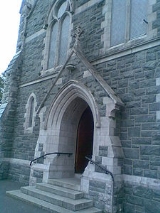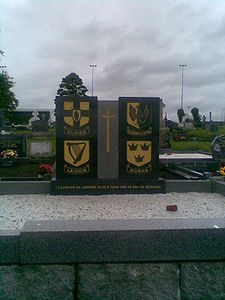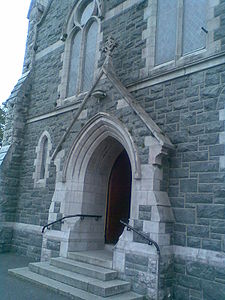
Ballymacnab
Encyclopedia
Ballymacnab is a townland
and village
in County Armagh
, Northern Ireland
. It is within the Parish of Cill Chluana, 7 miles south of the City of Armagh on the road towards Newtownhamilton
. It is within the Armagh City and District Council
area.

 Local buildings and amenities include Saint Patrick's Roman Catholic Church , Foley school , Ballymacnab Hall and the recently opened Mac's General Store. The local pub, O'Toole's Bar, was originally used a safe house
Local buildings and amenities include Saint Patrick's Roman Catholic Church , Foley school , Ballymacnab Hall and the recently opened Mac's General Store. The local pub, O'Toole's Bar, was originally used a safe house
for priests and is over 200 years old. It was named Northern Ireland Pub of The Year in 2009.
Seagahan Lake Reservoir is located to the east of the village, and includes the nearby dam
and Seagahan Water Treatment Works. Angling
is permitted at the reservoir, subject to certain restrictions. In May 2008, Northern Ireland Water commenced a £6.6 Million project to upgrade water treatment technology and infrastructure at the plant in order for it to comply with a new EU directive on water quality.
The closest settlements are Granemore to the west, Clady to the south, Corran to the south-west, Keady to the north west, Armagh to the north and Mullaghbrac to the east. The townland was previously part of lands confiscated from Catholic landowners and thereafter ceded to the Earl of Charlemont during the plantation of Ulster
, for example James Caulfeild, 3rd Earl of Charlemont
. The lands were worked by tenant farmers under the tithe
and con-acre system.
The majority Catholic population of Ballymacnab was reduced by emigration in the late nineteenth and early twentieth centuries. Many of the emigrants settled in the West of Scotland
and in particular, Glasgow
.
The Troubles in Keady
;
The Troubles in Armagh
and
Provisional IRA South Armagh Brigade
.
, after the same bull had knocked down the church he was building in Armaghbreague for the third consecutive night.
A mark which resembles the imprint of a Bull’s Foot remains to this day, and recent refurbishment work to the landmark has attempted to highlight the Bull’s Track as a tourist attraction.
side Ballymacnab Round Towers GAA club, who play their home games at Pairc na nGael. On 24th September 2011, the club reached the final of the Armagh Senior Football Championship for the first time in their history, after defeating local rivals Granemore
by 2-11 to 0-11. However, in the final they were comprehensively beaten by the favourites Crossmaglen Rangers
, one of Ireland's most famous clubs who were making their 55th appearance in an Armagh Senior Final, by a score of 2-22 to 0-03, on 16th October 2011 at the Athletic Grounds
in Armagh.
Ballymacnab is also home to the successful Saint Brenda's Camogie
club.
Townland
A townland or bally is a small geographical division of land used in Ireland. The townland system is of Gaelic origin—most townlands are believed to pre-date the Norman invasion and most have names derived from the Irish language...
and village
Village
A village is a clustered human settlement or community, larger than a hamlet with the population ranging from a few hundred to a few thousand , Though often located in rural areas, the term urban village is also applied to certain urban neighbourhoods, such as the West Village in Manhattan, New...
in County Armagh
County Armagh
-History:Ancient Armagh was the territory of the Ulaid before the fourth century AD. It was ruled by the Red Branch, whose capital was Emain Macha near Armagh. The site, and subsequently the city, were named after the goddess Macha...
, Northern Ireland
Northern Ireland
Northern Ireland is one of the four countries of the United Kingdom. Situated in the north-east of the island of Ireland, it shares a border with the Republic of Ireland to the south and west...
. It is within the Parish of Cill Chluana, 7 miles south of the City of Armagh on the road towards Newtownhamilton
Newtownhamilton
Newtownhamilton is a small village in County Armagh, Northern Ireland. It is within the townland of Tullyvallan and the barony of Upper Fews. It is part of the Newry and Mourne District Council area...
. It is within the Armagh City and District Council
Armagh City and District Council
Armagh City and District Council is a district council in County Armagh in Northern Ireland. It includes the city of Armagh, as well as the surrounding area and its population is about 54,000. City status was officially conferred in 1995...
area.
Geography & History


Safe house
In the jargon of law enforcement and intelligence agencies, a safe house is a secure location, suitable for hiding witnesses, agents or other persons perceived as being in danger...
for priests and is over 200 years old. It was named Northern Ireland Pub of The Year in 2009.
Seagahan Lake Reservoir is located to the east of the village, and includes the nearby dam
Dam
A dam is a barrier that impounds water or underground streams. Dams generally serve the primary purpose of retaining water, while other structures such as floodgates or levees are used to manage or prevent water flow into specific land regions. Hydropower and pumped-storage hydroelectricity are...
and Seagahan Water Treatment Works. Angling
Angling
Angling is a method of fishing by means of an "angle" . The hook is usually attached to a fishing line and the line is often attached to a fishing rod. Fishing rods are usually fitted with a fishing reel that functions as a mechanism for storing, retrieving and paying out the line. The hook itself...
is permitted at the reservoir, subject to certain restrictions. In May 2008, Northern Ireland Water commenced a £6.6 Million project to upgrade water treatment technology and infrastructure at the plant in order for it to comply with a new EU directive on water quality.
The closest settlements are Granemore to the west, Clady to the south, Corran to the south-west, Keady to the north west, Armagh to the north and Mullaghbrac to the east. The townland was previously part of lands confiscated from Catholic landowners and thereafter ceded to the Earl of Charlemont during the plantation of Ulster
Plantation of Ulster
The Plantation of Ulster was the organised colonisation of Ulster—a province of Ireland—by people from Great Britain. Private plantation by wealthy landowners began in 1606, while official plantation controlled by King James I of England and VI of Scotland began in 1609...
, for example James Caulfeild, 3rd Earl of Charlemont
James Caulfeild, 3rd Earl of Charlemont
Sir James Molyneux Caulfeild, 3rd Earl of Charlemont KP was an Irish politician and peer.He was the son of Hon. Henry Caulfeild and Elizabeth Margaret Browne. Lord Charlemont married on two occasions;* Hon...
. The lands were worked by tenant farmers under the tithe
Tithe
A tithe is a one-tenth part of something, paid as a contribution to a religious organization or compulsory tax to government. Today, tithes are normally voluntary and paid in cash, cheques, or stocks, whereas historically tithes were required and paid in kind, such as agricultural products...
and con-acre system.
The majority Catholic population of Ballymacnab was reduced by emigration in the late nineteenth and early twentieth centuries. Many of the emigrants settled in the West of Scotland
West of Scotland
West of Scotland may refer to:*West of Scotland, an electoral region of the Scottish Parliament*Informally, an area comprising Argyll, Ayrshire, Dunbartonshire, Lanarkshire, and Renfrewshire*West of Scotland Football Club*West of Scotland Cricket Club...
and in particular, Glasgow
Glasgow
Glasgow is the largest city in Scotland and third most populous in the United Kingdom. The city is situated on the River Clyde in the country's west central lowlands...
.
The Troubles
For more information seeThe Troubles in Keady
The Troubles in Keady
The Troubles in Keady recounts incidents during, and the effects of, The Troubles in Keady, County Armagh, Northern Ireland.Incidents in Keady during the Troubles resulting in two or more fatalities:-1976:...
;
The Troubles in Armagh
The Troubles in Armagh
The Troubles in Armagh recounts incidents during, and the effects of, The Troubles in Armagh, County Armagh, Northern Ireland.Incidents in Armagh during the Troubles:-1975:...
and
Provisional IRA South Armagh Brigade
Provisional IRA South Armagh Brigade
The South Armagh Brigade of the Provisional Irish Republican Army operated during the Troubles in south County Armagh. It was organised into two battalions, one around Jonesborough and another around Crossmaglen. By the 1990s, the South Armagh Brigade was thought to consist of about 40 members,...
.
Culture
In common with much of County Armagh, the area is referred to in local history and folklore. One famous story concerns the ‘Bull’s Track’. This is a landmark at the junction of the main Armagh/Newtownhamilton road and the Ballymacnab Road that leads to Seagahan Dam. A large stone marks the spot where it is claimed a large black bull landed after having been flung from neighbouring Armaghbreague Mountain by an angry Saint PatrickSaint Patrick
Saint Patrick was a Romano-Briton and Christian missionary, who is the most generally recognized patron saint of Ireland or the Apostle of Ireland, although Brigid of Kildare and Colmcille are also formally patron saints....
, after the same bull had knocked down the church he was building in Armaghbreague for the third consecutive night.
A mark which resembles the imprint of a Bull’s Foot remains to this day, and recent refurbishment work to the landmark has attempted to highlight the Bull’s Track as a tourist attraction.
Sport
Ballymacnab is home to Gaelic FootballGaelic football
Gaelic football , commonly referred to as "football" or "Gaelic", or "Gah" is a form of football played mainly in Ireland...
side Ballymacnab Round Towers GAA club, who play their home games at Pairc na nGael. On 24th September 2011, the club reached the final of the Armagh Senior Football Championship for the first time in their history, after defeating local rivals Granemore
Granemore
Granemore is a small townland located in County Armagh, Northern Ireland, about seven miles from Armagh and three miles from Keady...
by 2-11 to 0-11. However, in the final they were comprehensively beaten by the favourites Crossmaglen Rangers
Crossmaglen Rangers
Crossmaglen Rangers G.A.C is a Gaelic Athletic Association club from Armagh, County Armagh, Northern Ireland. They cater for Gaelic football and camogie. Their home football ground is St. Oliver Plunkett Park which was opened in 1959...
, one of Ireland's most famous clubs who were making their 55th appearance in an Armagh Senior Final, by a score of 2-22 to 0-03, on 16th October 2011 at the Athletic Grounds
Athletic Grounds
The Athletic Grounds is a Gaelic Athletic Association stadium in Armagh, Northern Ireland. It is the county ground and administrative headquarters of Armagh GAA and is used for both gaelic football and hurling. Following sponsorship from the Morgan Group the stadium is known as the Morgan Athletic...
in Armagh.
Ballymacnab is also home to the successful Saint Brenda's Camogie
Camogie
Camogie is an Irish stick-and-ball team sport played by women; it is almost identical to the game of hurling played by men. Camogie is played by 100,000 women in Ireland and world wide, largely among Irish communities....
club.
External links
- Ballymacnab Gaelic Football Club - Official Site of the local GAAGaelic Athletic AssociationThe Gaelic Athletic Association is an amateur Irish and international cultural and sporting organisation focused primarily on promoting Gaelic games, which include the traditional Irish sports of hurling, camogie, Gaelic football, handball and rounders...
football club. - Saint Brenda's Ballymacnab Camogie Club - Official Site of the local Camogie club.
- Ballymacnab Community Development Association - Local social, economic and cultural association.
- Seagahan Lake Reservoir - Discover Northern Ireland tourism webpage.
- local stories - Extracts from a book Entitled: Country Cracks: Old Tales from the County of Armagh by T. G. F. Paterson , curator of Armagh County Museum.

